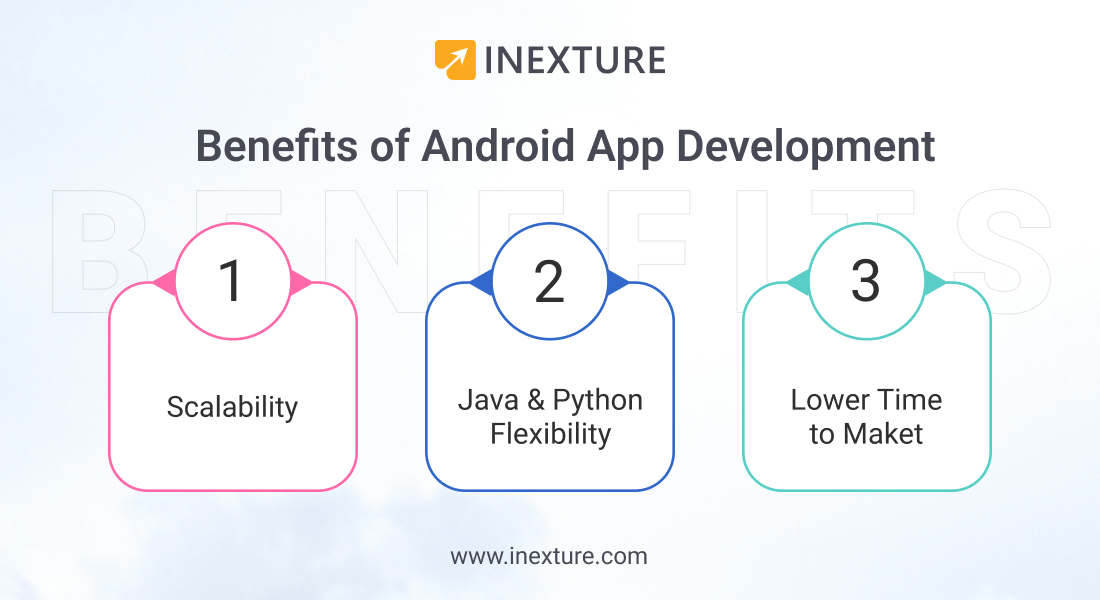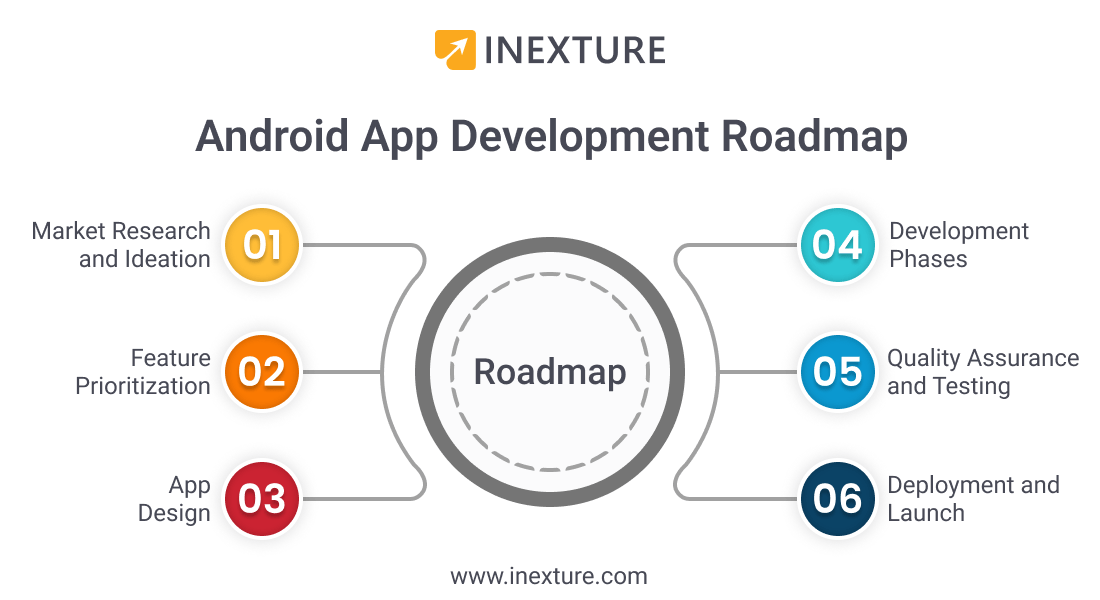Digital Transformation Consulting: Cost, Strategy,...
October 13, 2025

Android has become the dominant operating system worldwide, and its popularity is only growing. With over 3 billion active users, Android powers more than 75% of the total mobile app market.
As businesses increasingly go digital, Android apps offer a unique opportunity to scale and connect with a global audience. This comprehensive guide will dive into Android app development costs, the benefits of developing Android apps, and the latest trends for 2024.
Android app development is a strategic choice for businesses looking to expand their digital footprint. Here’s why:
With Android commanding a vast majority of the mobile OS market, creating an Android app offers access to a diverse and massive audience. This wide reach helps businesses connect with various demographics, offering more potential for user acquisition and engagement.
Android is open-source, making it highly adaptable for developers. Whether integrating advanced features or optimizing for various devices, Android apps can be tailored to meet specific business needs. With Android app development software offering a wide range of libraries, tools, and frameworks, developers have greater flexibility in app creation.
One of the biggest advantages of Android app development is its cost efficiency. The development and testing processes are more affordable compared to other platforms. The one-time registration fee of $25 for publishing on Google Play makes it accessible for businesses of all sizes.
Android offers numerous benefits that make it the go-to platform for businesses and developers:

As businesses grow, so do their app needs. Android apps are highly scalable and can accommodate future upgrades and modifications.
With support for both Java and Python, Android development is more flexible. Java is one of the most popular programming languages for Android app development, offering stability and versatility. Android app development using Python is also gaining traction due to its simplicity and efficiency.
Android development tools like Android Studio enable faster development and deployment. Businesses can get their products to market more quickly, staying ahead of the competition.
Keeping up with trends is essential for staying relevant in the competitive app market. Here are the key trends shaping Android app development in 2024:
AI and ML are transforming how apps function, from personalized user experiences to advanced analytics. AI-driven app features are on the rise, and integrating them into Android apps can enhance user engagement and functionality.
With the growing adoption of 5G, Android apps can now leverage faster speeds and lower latency. This will improve the overall user experience and open new possibilities for app developers.
Tools like React Native and Flutter are enabling cross-platform app development, allowing businesses to deploy apps on both Android and iOS with a single codebase. This trend reduces development costs and increases market reach.
When planning your Android app development, understanding the factors influencing the cost is essential. Here’s a comprehensive breakdown:
App Complexity | Development Time | Cost Estimate ($50/hr) | Cost Estimate ($100/hr) |
Simple | 400 hours | $20,000 | $40,000 |
Moderate | 500-800 hours | $40,000 | $80,000 |
Advanced | 800-1500 hours | $75,000 | $150,000 |
Simple apps with basic functionality will cost less, while more complex apps with advanced features will demand higher development time and budget.
The type of app you develop—Native, Hybrid, or Progressive Web Apps (PWAs)—also impacts the cost.
App Type | Technology Used | Cost Estimate |
Native App | Objective C, Python, Swift, Kotlin, Java | $100,000+ |
Hybrid App | HTML 5, Ionic, React Native, Flutter | $5,000 – $100,000 |
| Progressive Web App | Ruby, JavaScript, CSS, HTML | $20,000 – $40,000 |
Native apps are developed for specific platforms, while hybrid apps can run on multiple platforms, reducing costs. PWAs provide app-like functionality on the web, offering a cost-effective solution.
The category of your app also influences its development cost, as different categories demand different features and functionalities.
App Category | Examples | Cost Estimate |
On-Demand Apps | DoorDash, Uber | $150,000 – $300,000 |
Health and Fitness | Fitbit, MyFitnessPal | $100,000 – $200,000 |
Social Media Apps | Facebook, Instagram | $300,000 – $500,000+ |
E-commerce | eBay, Etsy | $100,000 – $300,000 |
A well-structured Android app development roadmap is essential to guide your project from ideation to deployment and beyond. It not only ensures that the development process stays on track but also helps in managing resources effectively. Here’s a step-by-step approach:

Analyze the Competition: Start by understanding what your competitors are offering. Look for gaps in the market and identify unique features that could set your app apart.
Define Target Audience: Conduct market research to identify the specific demographics your app will cater to. A deep understanding of user behavior and preferences will shape your app’s features.
Must-Have Features: List out the core functionalities your app needs to serve its primary purpose.
Nice-to-Have Features: These are features that can enhance user experience but are not critical to launch. You can introduce these in future updates.
Technology Stack: Decide on the technology stack, including programming languages like Java and Python and development tools such as Android Studio and Android app development software.
UI/UX Wireframing: Create wireframes to visualize the app’s layout and flow. The focus here should be on ensuring a seamless user experience.
Prototype Development: Develop an interactive prototype to simulate the app’s functionality and gather feedback early in the process.
Backend Development: Set up servers, databases, and APIs required to run the app. Ensure that the backend infrastructure is scalable and secure.
Frontend Development: Develop the user-facing side of the app, focusing on user interface (UI) elements, animations, and responsive design.
Feature Testing: Implement iterative testing during development to catch bugs early and refine features based on performance.
Automated Testing: Run automated tests for scalability, security, and performance under various load conditions.
Beta Testing: Release the app to a select group of users for feedback. Identify usability issues and implement any necessary adjustments before the public launch.
App Store Optimization (ASO): Ensure your app’s listing on Google Play Store is optimized with relevant keywords, an appealing description, and eye-catching visuals.
Post-Launch Updates: Plan a strategy for regular updates, including bug fixes, new features, and optimizations based on user feedback.
By following a structured Android app development roadmap, you can ensure that your project is completed efficiently, within budget, and meets your business objectives.
Reducing the cost of Android app development doesn’t mean compromising on quality. With strategic planning, you can deliver a high-quality app within a manageable budget. Here are some effective cost-cutting strategies:
Developing a fully-featured app from the start can be expensive and time-consuming. An MVP focuses only on the core features necessary for launch. This allows you to bring your app to market faster and gather user feedback to guide future development.
Hiring an in-house development team can be costly. Instead, consider outsourcing your Android app development to experienced firms like Inexture Solutions. Outsourcing to regions with lower development costs, without compromising on quality, can significantly reduce overall expenses.
Tools like React Native and Flutter allow you to build apps that run on both Android and iOS with a single codebase. This reduces development time and costs compared to developing separate native apps for each platform.
Rather than building every component from scratch, use open-source libraries and tools to expedite development. The Android ecosystem offers numerous libraries that can help you implement common features like user authentication, payment gateways, and more.
Prioritize features that are critical for your app’s functionality and user experience. Avoid adding unnecessary features that can increase development time and costs. You can always introduce additional features through updates once your app gains traction.
Automated testing tools help identify bugs and performance issues early, reducing the cost of fixing them later. Automated tests are particularly helpful for regression testing, which ensures that new features don’t break existing functionality.
Negotiate the right pricing model with your app development partner. Options include fixed-price models for projects with well-defined scopes or time-and-material models for projects that may evolve. Ensure that the model aligns with your budget and development expectations.
Regular app maintenance is crucial for its long-term success, but it can add up if not planned for in advance. Plan for ongoing maintenance, updates, and bug fixes in your initial budget to avoid unexpected costs.
Opt for cloud platforms like AWS, Google Cloud, or Microsoft Azure for backend services. Cloud infrastructure provides cost-effective scalability, ensuring you only pay for the resources you use, without needing to maintain expensive in-house servers.
By applying these cost-effective strategies, you can manage your Android app development cost while ensuring a high-quality and scalable product that meets your business needs.
As an Android App Development Company, we’ve seen how Android app development continues to dominate the mobile app market in 2024, offering businesses the chance to reach billions of users. Whether you’re a startup or a well-established company, understanding the costs, choosing the right app development roadmap, and leveraging the latest trends will ensure your app’s success.
If you’re considering Android app development for your business, Inexture Solutions is your trusted partner. We offer a comprehensive suite of services, from Android app development consultation to UI/UX design, development, and multi-platform deployment. Contact us today to learn more about how we can bring your app vision to life!